Business Strategy Report: HSBC Bank's Competitive Advantage Analysis
VerifiedAdded on 2021/02/20
|14
|4200
|192
Report
AI Summary
This report provides a comprehensive analysis of HSBC's business strategy, focusing on its application of various strategic management tools. The introduction establishes the importance of business strategy and highlights HSBC as a case study, emphasizing its global presence and diverse financial services. The main body delves into the impact of the macro-environment through PESTLE analysis, examining political, economic, social, technological, legal, and environmental factors influencing HSBC's operations. The internal environment is assessed using SWOT analysis to identify the bank's strengths, weaknesses, opportunities, and threats. Furthermore, Porter's Five Forces are applied to analyze the competitive landscape of the banking industry. The report concludes with strategic recommendations for HSBC, based on the analyses conducted, offering insights into maintaining a competitive advantage and achieving long-term profitability. The report includes references to support the analysis and findings.
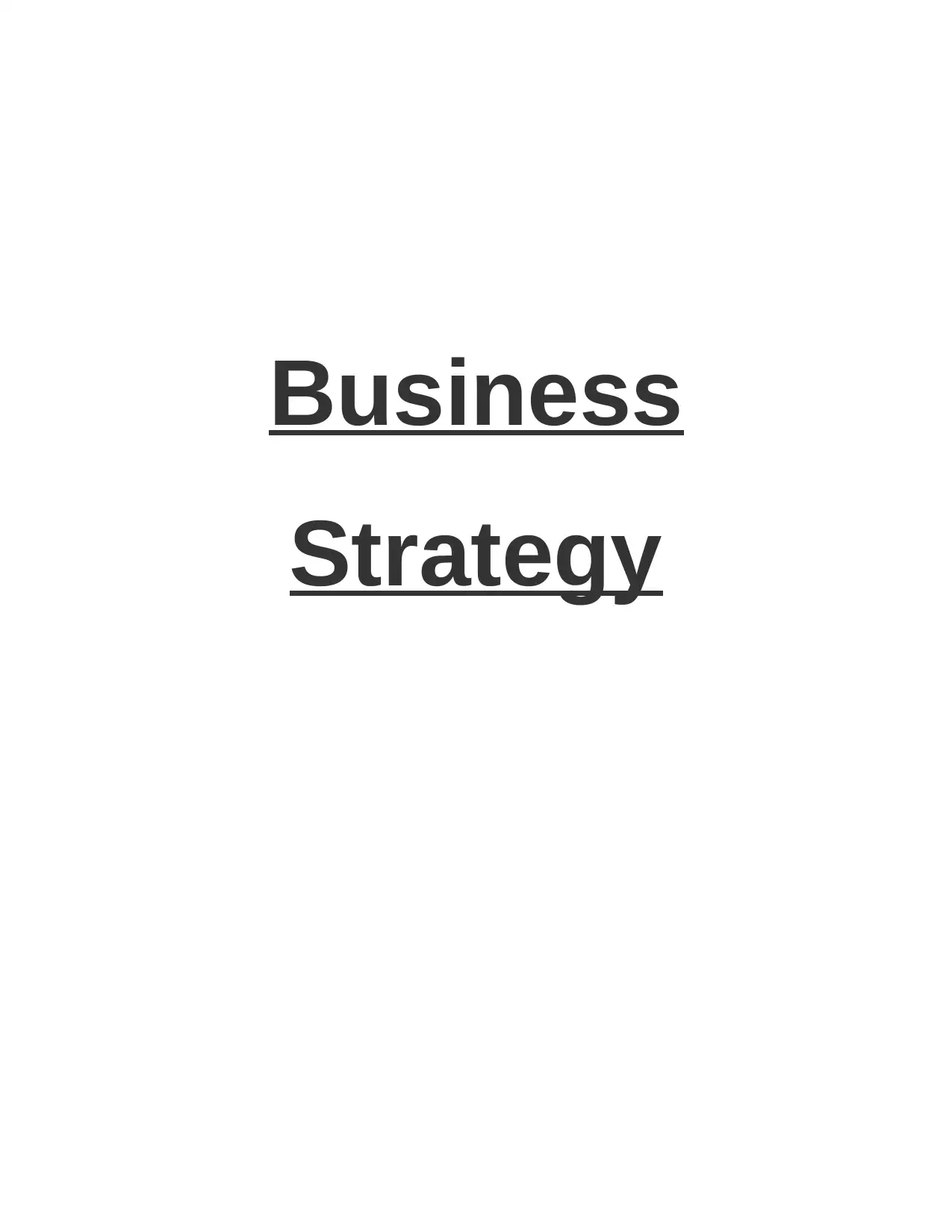
Business
Strategy
Strategy
Paraphrase This Document
Need a fresh take? Get an instant paraphrase of this document with our AI Paraphraser
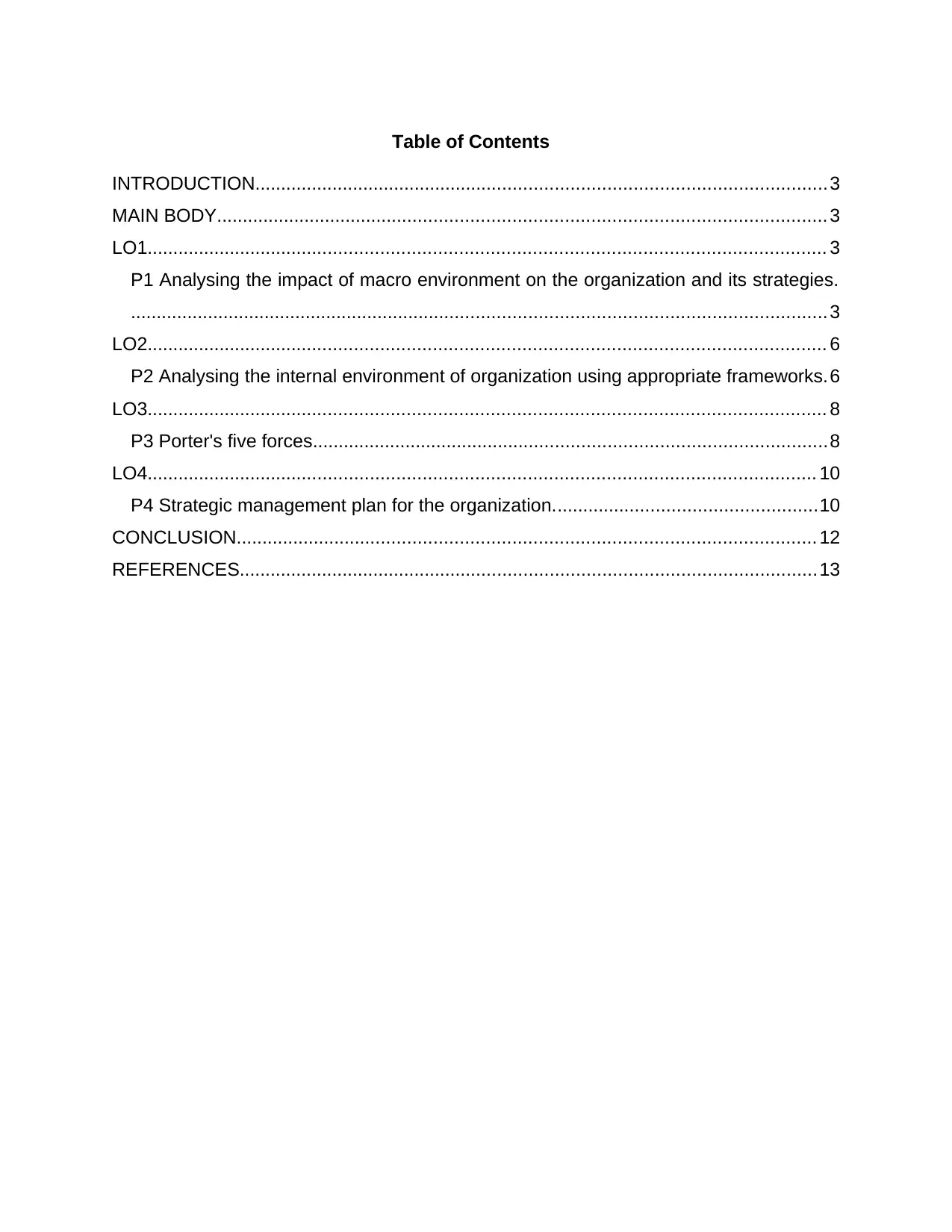
Table of Contents
INTRODUCTION..............................................................................................................3
MAIN BODY..................................................................................................................... 3
LO1.................................................................................................................................. 3
P1 Analysing the impact of macro environment on the organization and its strategies.
......................................................................................................................................3
LO2.................................................................................................................................. 6
P2 Analysing the internal environment of organization using appropriate frameworks.6
LO3.................................................................................................................................. 8
P3 Porter's five forces...................................................................................................8
LO4................................................................................................................................ 10
P4 Strategic management plan for the organization...................................................10
CONCLUSION............................................................................................................... 12
REFERENCES...............................................................................................................13
INTRODUCTION..............................................................................................................3
MAIN BODY..................................................................................................................... 3
LO1.................................................................................................................................. 3
P1 Analysing the impact of macro environment on the organization and its strategies.
......................................................................................................................................3
LO2.................................................................................................................................. 6
P2 Analysing the internal environment of organization using appropriate frameworks.6
LO3.................................................................................................................................. 8
P3 Porter's five forces...................................................................................................8
LO4................................................................................................................................ 10
P4 Strategic management plan for the organization...................................................10
CONCLUSION............................................................................................................... 12
REFERENCES...............................................................................................................13
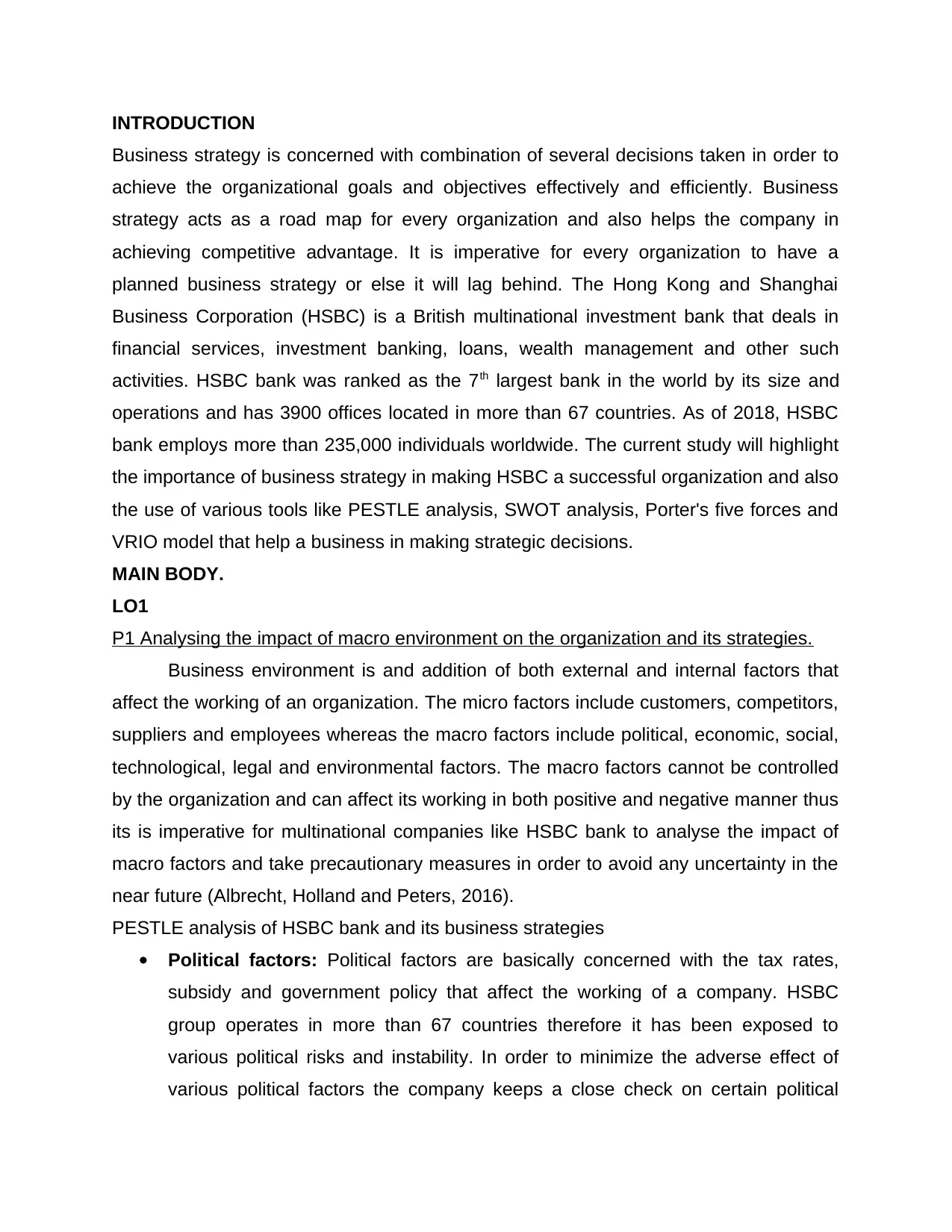
INTRODUCTION
Business strategy is concerned with combination of several decisions taken in order to
achieve the organizational goals and objectives effectively and efficiently. Business
strategy acts as a road map for every organization and also helps the company in
achieving competitive advantage. It is imperative for every organization to have a
planned business strategy or else it will lag behind. The Hong Kong and Shanghai
Business Corporation (HSBC) is a British multinational investment bank that deals in
financial services, investment banking, loans, wealth management and other such
activities. HSBC bank was ranked as the 7th largest bank in the world by its size and
operations and has 3900 offices located in more than 67 countries. As of 2018, HSBC
bank employs more than 235,000 individuals worldwide. The current study will highlight
the importance of business strategy in making HSBC a successful organization and also
the use of various tools like PESTLE analysis, SWOT analysis, Porter's five forces and
VRIO model that help a business in making strategic decisions.
MAIN BODY.
LO1
P1 Analysing the impact of macro environment on the organization and its strategies.
Business environment is and addition of both external and internal factors that
affect the working of an organization. The micro factors include customers, competitors,
suppliers and employees whereas the macro factors include political, economic, social,
technological, legal and environmental factors. The macro factors cannot be controlled
by the organization and can affect its working in both positive and negative manner thus
its is imperative for multinational companies like HSBC bank to analyse the impact of
macro factors and take precautionary measures in order to avoid any uncertainty in the
near future (Albrecht, Holland and Peters, 2016).
PESTLE analysis of HSBC bank and its business strategies
Political factors: Political factors are basically concerned with the tax rates,
subsidy and government policy that affect the working of a company. HSBC
group operates in more than 67 countries therefore it has been exposed to
various political risks and instability. In order to minimize the adverse effect of
various political factors the company keeps a close check on certain political
Business strategy is concerned with combination of several decisions taken in order to
achieve the organizational goals and objectives effectively and efficiently. Business
strategy acts as a road map for every organization and also helps the company in
achieving competitive advantage. It is imperative for every organization to have a
planned business strategy or else it will lag behind. The Hong Kong and Shanghai
Business Corporation (HSBC) is a British multinational investment bank that deals in
financial services, investment banking, loans, wealth management and other such
activities. HSBC bank was ranked as the 7th largest bank in the world by its size and
operations and has 3900 offices located in more than 67 countries. As of 2018, HSBC
bank employs more than 235,000 individuals worldwide. The current study will highlight
the importance of business strategy in making HSBC a successful organization and also
the use of various tools like PESTLE analysis, SWOT analysis, Porter's five forces and
VRIO model that help a business in making strategic decisions.
MAIN BODY.
LO1
P1 Analysing the impact of macro environment on the organization and its strategies.
Business environment is and addition of both external and internal factors that
affect the working of an organization. The micro factors include customers, competitors,
suppliers and employees whereas the macro factors include political, economic, social,
technological, legal and environmental factors. The macro factors cannot be controlled
by the organization and can affect its working in both positive and negative manner thus
its is imperative for multinational companies like HSBC bank to analyse the impact of
macro factors and take precautionary measures in order to avoid any uncertainty in the
near future (Albrecht, Holland and Peters, 2016).
PESTLE analysis of HSBC bank and its business strategies
Political factors: Political factors are basically concerned with the tax rates,
subsidy and government policy that affect the working of a company. HSBC
group operates in more than 67 countries therefore it has been exposed to
various political risks and instability. In order to minimize the adverse effect of
various political factors the company keeps a close check on certain political
⊘ This is a preview!⊘
Do you want full access?
Subscribe today to unlock all pages.

Trusted by 1+ million students worldwide
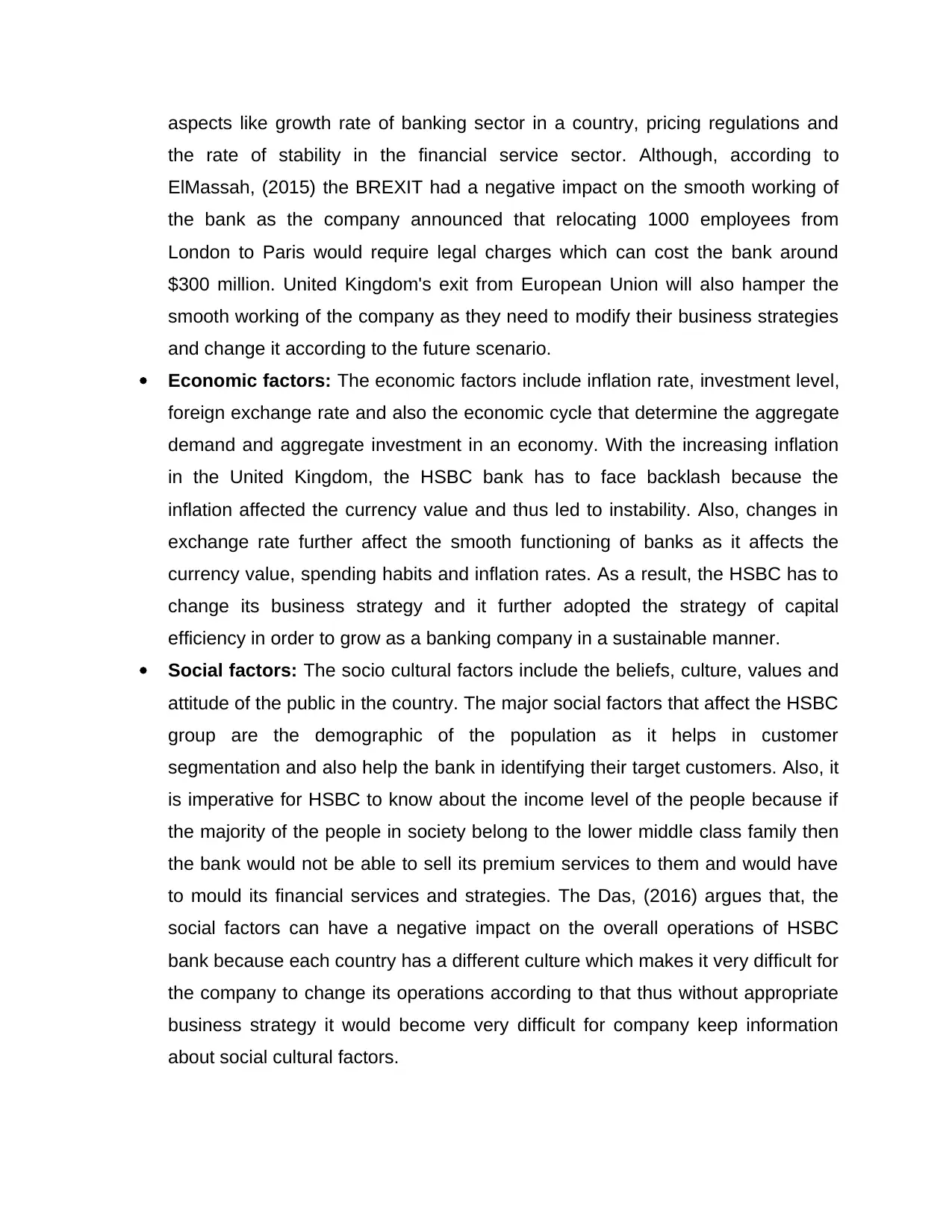
aspects like growth rate of banking sector in a country, pricing regulations and
the rate of stability in the financial service sector. Although, according to
ElMassah, (2015) the BREXIT had a negative impact on the smooth working of
the bank as the company announced that relocating 1000 employees from
London to Paris would require legal charges which can cost the bank around
$300 million. United Kingdom's exit from European Union will also hamper the
smooth working of the company as they need to modify their business strategies
and change it according to the future scenario.
Economic factors: The economic factors include inflation rate, investment level,
foreign exchange rate and also the economic cycle that determine the aggregate
demand and aggregate investment in an economy. With the increasing inflation
in the United Kingdom, the HSBC bank has to face backlash because the
inflation affected the currency value and thus led to instability. Also, changes in
exchange rate further affect the smooth functioning of banks as it affects the
currency value, spending habits and inflation rates. As a result, the HSBC has to
change its business strategy and it further adopted the strategy of capital
efficiency in order to grow as a banking company in a sustainable manner.
Social factors: The socio cultural factors include the beliefs, culture, values and
attitude of the public in the country. The major social factors that affect the HSBC
group are the demographic of the population as it helps in customer
segmentation and also help the bank in identifying their target customers. Also, it
is imperative for HSBC to know about the income level of the people because if
the majority of the people in society belong to the lower middle class family then
the bank would not be able to sell its premium services to them and would have
to mould its financial services and strategies. The Das, (2016) argues that, the
social factors can have a negative impact on the overall operations of HSBC
bank because each country has a different culture which makes it very difficult for
the company to change its operations according to that thus without appropriate
business strategy it would become very difficult for company keep information
about social cultural factors.
the rate of stability in the financial service sector. Although, according to
ElMassah, (2015) the BREXIT had a negative impact on the smooth working of
the bank as the company announced that relocating 1000 employees from
London to Paris would require legal charges which can cost the bank around
$300 million. United Kingdom's exit from European Union will also hamper the
smooth working of the company as they need to modify their business strategies
and change it according to the future scenario.
Economic factors: The economic factors include inflation rate, investment level,
foreign exchange rate and also the economic cycle that determine the aggregate
demand and aggregate investment in an economy. With the increasing inflation
in the United Kingdom, the HSBC bank has to face backlash because the
inflation affected the currency value and thus led to instability. Also, changes in
exchange rate further affect the smooth functioning of banks as it affects the
currency value, spending habits and inflation rates. As a result, the HSBC has to
change its business strategy and it further adopted the strategy of capital
efficiency in order to grow as a banking company in a sustainable manner.
Social factors: The socio cultural factors include the beliefs, culture, values and
attitude of the public in the country. The major social factors that affect the HSBC
group are the demographic of the population as it helps in customer
segmentation and also help the bank in identifying their target customers. Also, it
is imperative for HSBC to know about the income level of the people because if
the majority of the people in society belong to the lower middle class family then
the bank would not be able to sell its premium services to them and would have
to mould its financial services and strategies. The Das, (2016) argues that, the
social factors can have a negative impact on the overall operations of HSBC
bank because each country has a different culture which makes it very difficult for
the company to change its operations according to that thus without appropriate
business strategy it would become very difficult for company keep information
about social cultural factors.
Paraphrase This Document
Need a fresh take? Get an instant paraphrase of this document with our AI Paraphraser
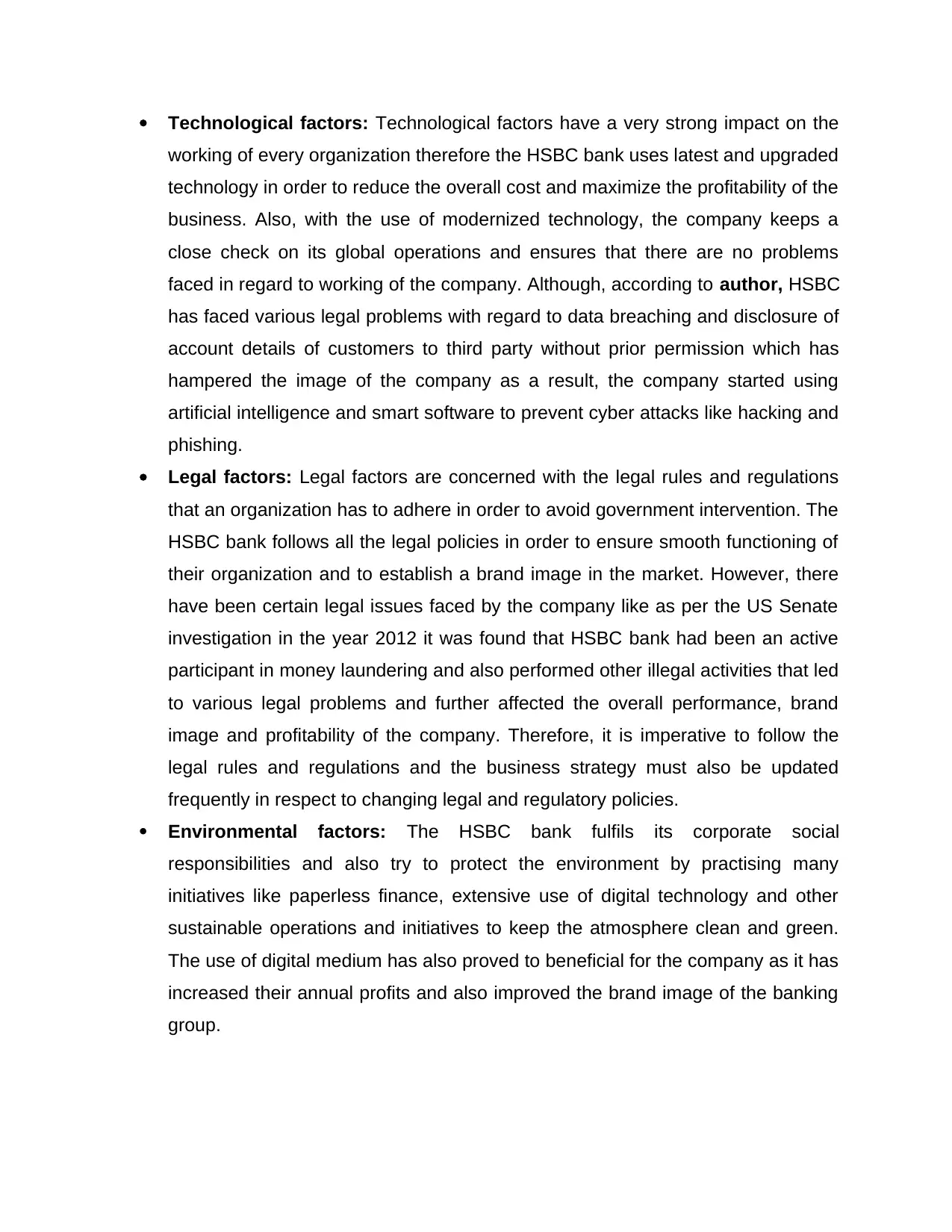
Technological factors: Technological factors have a very strong impact on the
working of every organization therefore the HSBC bank uses latest and upgraded
technology in order to reduce the overall cost and maximize the profitability of the
business. Also, with the use of modernized technology, the company keeps a
close check on its global operations and ensures that there are no problems
faced in regard to working of the company. Although, according to author, HSBC
has faced various legal problems with regard to data breaching and disclosure of
account details of customers to third party without prior permission which has
hampered the image of the company as a result, the company started using
artificial intelligence and smart software to prevent cyber attacks like hacking and
phishing.
Legal factors: Legal factors are concerned with the legal rules and regulations
that an organization has to adhere in order to avoid government intervention. The
HSBC bank follows all the legal policies in order to ensure smooth functioning of
their organization and to establish a brand image in the market. However, there
have been certain legal issues faced by the company like as per the US Senate
investigation in the year 2012 it was found that HSBC bank had been an active
participant in money laundering and also performed other illegal activities that led
to various legal problems and further affected the overall performance, brand
image and profitability of the company. Therefore, it is imperative to follow the
legal rules and regulations and the business strategy must also be updated
frequently in respect to changing legal and regulatory policies.
Environmental factors: The HSBC bank fulfils its corporate social
responsibilities and also try to protect the environment by practising many
initiatives like paperless finance, extensive use of digital technology and other
sustainable operations and initiatives to keep the atmosphere clean and green.
The use of digital medium has also proved to beneficial for the company as it has
increased their annual profits and also improved the brand image of the banking
group.
working of every organization therefore the HSBC bank uses latest and upgraded
technology in order to reduce the overall cost and maximize the profitability of the
business. Also, with the use of modernized technology, the company keeps a
close check on its global operations and ensures that there are no problems
faced in regard to working of the company. Although, according to author, HSBC
has faced various legal problems with regard to data breaching and disclosure of
account details of customers to third party without prior permission which has
hampered the image of the company as a result, the company started using
artificial intelligence and smart software to prevent cyber attacks like hacking and
phishing.
Legal factors: Legal factors are concerned with the legal rules and regulations
that an organization has to adhere in order to avoid government intervention. The
HSBC bank follows all the legal policies in order to ensure smooth functioning of
their organization and to establish a brand image in the market. However, there
have been certain legal issues faced by the company like as per the US Senate
investigation in the year 2012 it was found that HSBC bank had been an active
participant in money laundering and also performed other illegal activities that led
to various legal problems and further affected the overall performance, brand
image and profitability of the company. Therefore, it is imperative to follow the
legal rules and regulations and the business strategy must also be updated
frequently in respect to changing legal and regulatory policies.
Environmental factors: The HSBC bank fulfils its corporate social
responsibilities and also try to protect the environment by practising many
initiatives like paperless finance, extensive use of digital technology and other
sustainable operations and initiatives to keep the atmosphere clean and green.
The use of digital medium has also proved to beneficial for the company as it has
increased their annual profits and also improved the brand image of the banking
group.
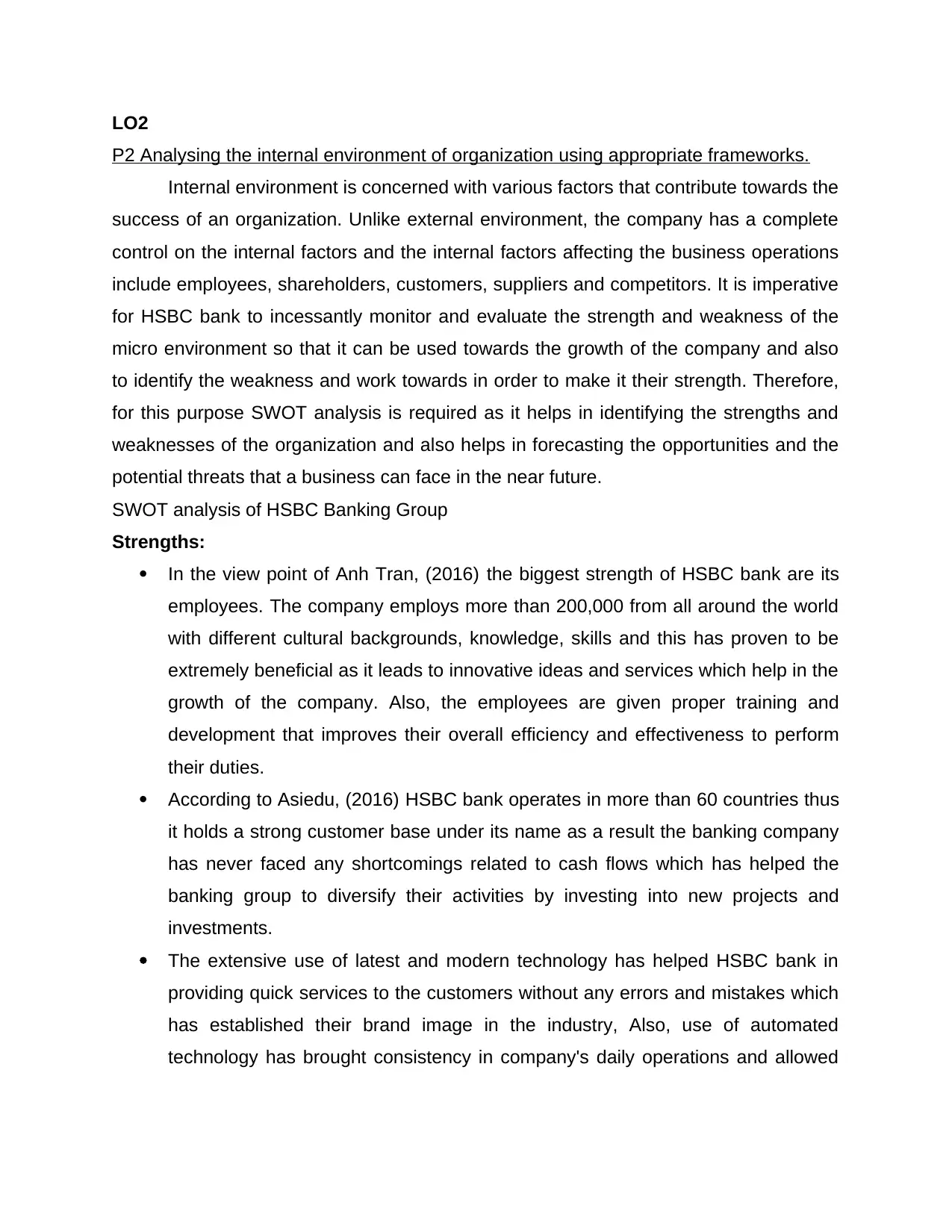
LO2
P2 Analysing the internal environment of organization using appropriate frameworks.
Internal environment is concerned with various factors that contribute towards the
success of an organization. Unlike external environment, the company has a complete
control on the internal factors and the internal factors affecting the business operations
include employees, shareholders, customers, suppliers and competitors. It is imperative
for HSBC bank to incessantly monitor and evaluate the strength and weakness of the
micro environment so that it can be used towards the growth of the company and also
to identify the weakness and work towards in order to make it their strength. Therefore,
for this purpose SWOT analysis is required as it helps in identifying the strengths and
weaknesses of the organization and also helps in forecasting the opportunities and the
potential threats that a business can face in the near future.
SWOT analysis of HSBC Banking Group
Strengths:
In the view point of Anh Tran, (2016) the biggest strength of HSBC bank are its
employees. The company employs more than 200,000 from all around the world
with different cultural backgrounds, knowledge, skills and this has proven to be
extremely beneficial as it leads to innovative ideas and services which help in the
growth of the company. Also, the employees are given proper training and
development that improves their overall efficiency and effectiveness to perform
their duties.
According to Asiedu, (2016) HSBC bank operates in more than 60 countries thus
it holds a strong customer base under its name as a result the banking company
has never faced any shortcomings related to cash flows which has helped the
banking group to diversify their activities by investing into new projects and
investments.
The extensive use of latest and modern technology has helped HSBC bank in
providing quick services to the customers without any errors and mistakes which
has established their brand image in the industry, Also, use of automated
technology has brought consistency in company's daily operations and allowed
P2 Analysing the internal environment of organization using appropriate frameworks.
Internal environment is concerned with various factors that contribute towards the
success of an organization. Unlike external environment, the company has a complete
control on the internal factors and the internal factors affecting the business operations
include employees, shareholders, customers, suppliers and competitors. It is imperative
for HSBC bank to incessantly monitor and evaluate the strength and weakness of the
micro environment so that it can be used towards the growth of the company and also
to identify the weakness and work towards in order to make it their strength. Therefore,
for this purpose SWOT analysis is required as it helps in identifying the strengths and
weaknesses of the organization and also helps in forecasting the opportunities and the
potential threats that a business can face in the near future.
SWOT analysis of HSBC Banking Group
Strengths:
In the view point of Anh Tran, (2016) the biggest strength of HSBC bank are its
employees. The company employs more than 200,000 from all around the world
with different cultural backgrounds, knowledge, skills and this has proven to be
extremely beneficial as it leads to innovative ideas and services which help in the
growth of the company. Also, the employees are given proper training and
development that improves their overall efficiency and effectiveness to perform
their duties.
According to Asiedu, (2016) HSBC bank operates in more than 60 countries thus
it holds a strong customer base under its name as a result the banking company
has never faced any shortcomings related to cash flows which has helped the
banking group to diversify their activities by investing into new projects and
investments.
The extensive use of latest and modern technology has helped HSBC bank in
providing quick services to the customers without any errors and mistakes which
has established their brand image in the industry, Also, use of automated
technology has brought consistency in company's daily operations and allowed
⊘ This is a preview!⊘
Do you want full access?
Subscribe today to unlock all pages.

Trusted by 1+ million students worldwide
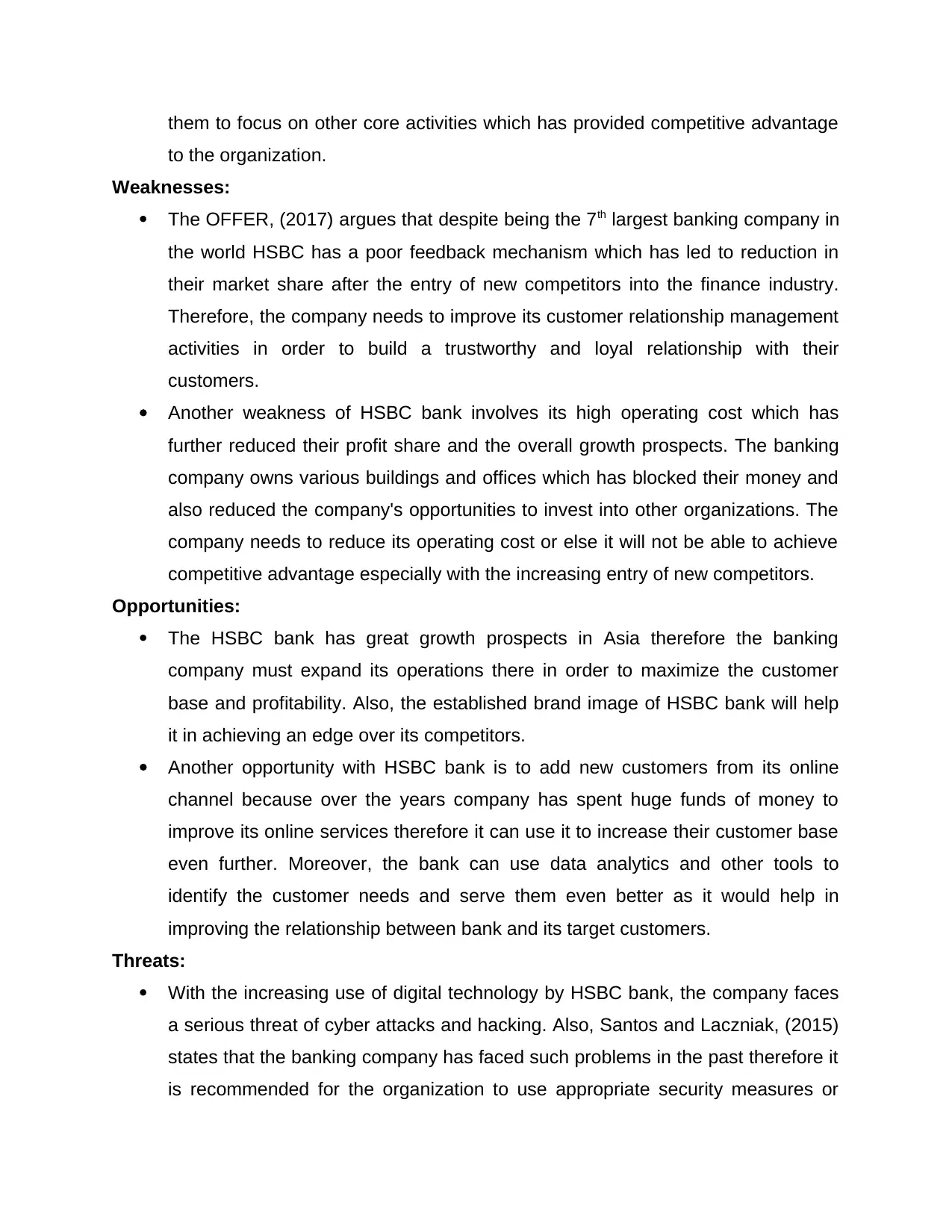
them to focus on other core activities which has provided competitive advantage
to the organization.
Weaknesses:
The OFFER, (2017) argues that despite being the 7th largest banking company in
the world HSBC has a poor feedback mechanism which has led to reduction in
their market share after the entry of new competitors into the finance industry.
Therefore, the company needs to improve its customer relationship management
activities in order to build a trustworthy and loyal relationship with their
customers.
Another weakness of HSBC bank involves its high operating cost which has
further reduced their profit share and the overall growth prospects. The banking
company owns various buildings and offices which has blocked their money and
also reduced the company's opportunities to invest into other organizations. The
company needs to reduce its operating cost or else it will not be able to achieve
competitive advantage especially with the increasing entry of new competitors.
Opportunities:
The HSBC bank has great growth prospects in Asia therefore the banking
company must expand its operations there in order to maximize the customer
base and profitability. Also, the established brand image of HSBC bank will help
it in achieving an edge over its competitors.
Another opportunity with HSBC bank is to add new customers from its online
channel because over the years company has spent huge funds of money to
improve its online services therefore it can use it to increase their customer base
even further. Moreover, the bank can use data analytics and other tools to
identify the customer needs and serve them even better as it would help in
improving the relationship between bank and its target customers.
Threats:
With the increasing use of digital technology by HSBC bank, the company faces
a serious threat of cyber attacks and hacking. Also, Santos and Laczniak, (2015)
states that the banking company has faced such problems in the past therefore it
is recommended for the organization to use appropriate security measures or
to the organization.
Weaknesses:
The OFFER, (2017) argues that despite being the 7th largest banking company in
the world HSBC has a poor feedback mechanism which has led to reduction in
their market share after the entry of new competitors into the finance industry.
Therefore, the company needs to improve its customer relationship management
activities in order to build a trustworthy and loyal relationship with their
customers.
Another weakness of HSBC bank involves its high operating cost which has
further reduced their profit share and the overall growth prospects. The banking
company owns various buildings and offices which has blocked their money and
also reduced the company's opportunities to invest into other organizations. The
company needs to reduce its operating cost or else it will not be able to achieve
competitive advantage especially with the increasing entry of new competitors.
Opportunities:
The HSBC bank has great growth prospects in Asia therefore the banking
company must expand its operations there in order to maximize the customer
base and profitability. Also, the established brand image of HSBC bank will help
it in achieving an edge over its competitors.
Another opportunity with HSBC bank is to add new customers from its online
channel because over the years company has spent huge funds of money to
improve its online services therefore it can use it to increase their customer base
even further. Moreover, the bank can use data analytics and other tools to
identify the customer needs and serve them even better as it would help in
improving the relationship between bank and its target customers.
Threats:
With the increasing use of digital technology by HSBC bank, the company faces
a serious threat of cyber attacks and hacking. Also, Santos and Laczniak, (2015)
states that the banking company has faced such problems in the past therefore it
is recommended for the organization to use appropriate security measures or
Paraphrase This Document
Need a fresh take? Get an instant paraphrase of this document with our AI Paraphraser
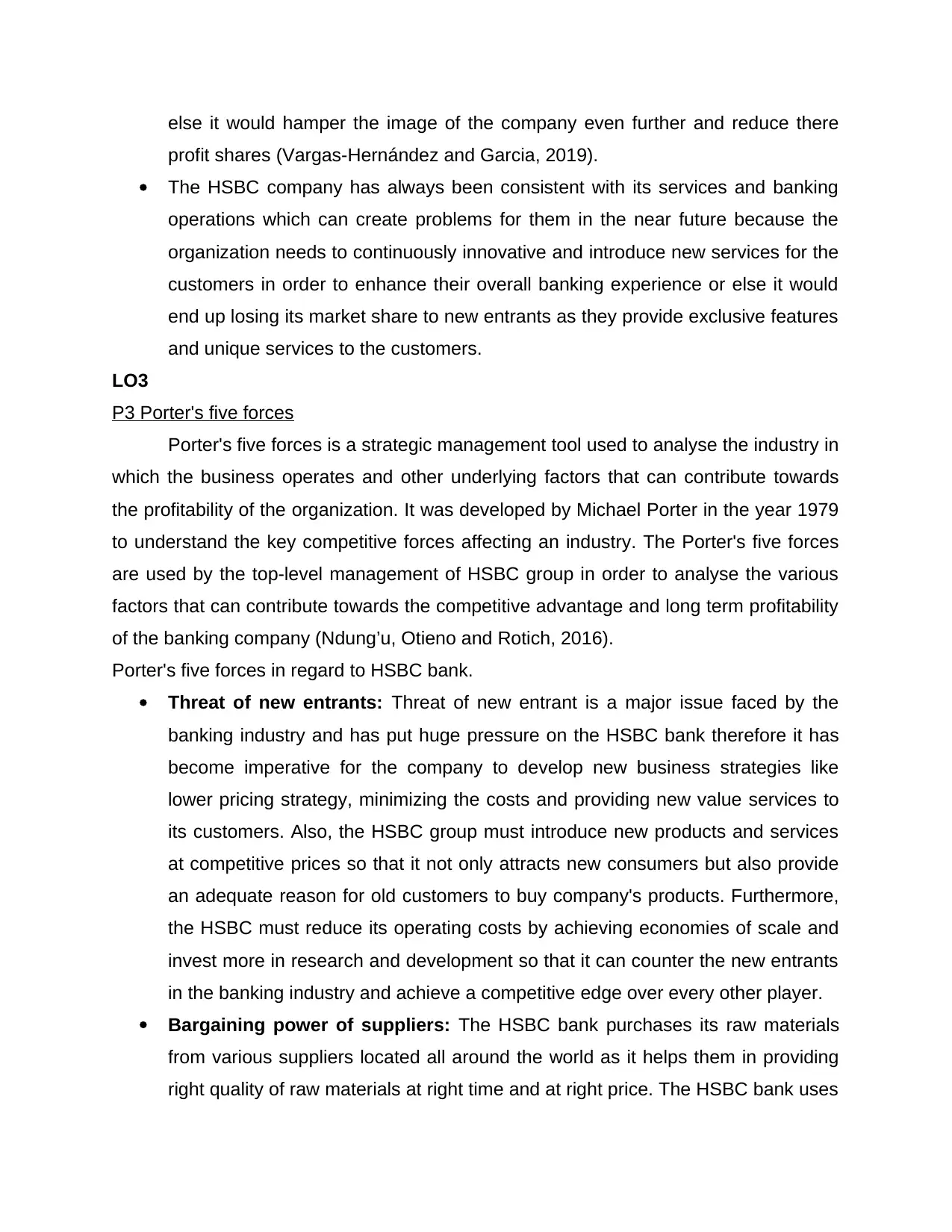
else it would hamper the image of the company even further and reduce there
profit shares (Vargas-Hernández and Garcia, 2019).
The HSBC company has always been consistent with its services and banking
operations which can create problems for them in the near future because the
organization needs to continuously innovative and introduce new services for the
customers in order to enhance their overall banking experience or else it would
end up losing its market share to new entrants as they provide exclusive features
and unique services to the customers.
LO3
P3 Porter's five forces
Porter's five forces is a strategic management tool used to analyse the industry in
which the business operates and other underlying factors that can contribute towards
the profitability of the organization. It was developed by Michael Porter in the year 1979
to understand the key competitive forces affecting an industry. The Porter's five forces
are used by the top-level management of HSBC group in order to analyse the various
factors that can contribute towards the competitive advantage and long term profitability
of the banking company (Ndung’u, Otieno and Rotich, 2016).
Porter's five forces in regard to HSBC bank.
Threat of new entrants: Threat of new entrant is a major issue faced by the
banking industry and has put huge pressure on the HSBC bank therefore it has
become imperative for the company to develop new business strategies like
lower pricing strategy, minimizing the costs and providing new value services to
its customers. Also, the HSBC group must introduce new products and services
at competitive prices so that it not only attracts new consumers but also provide
an adequate reason for old customers to buy company's products. Furthermore,
the HSBC must reduce its operating costs by achieving economies of scale and
invest more in research and development so that it can counter the new entrants
in the banking industry and achieve a competitive edge over every other player.
Bargaining power of suppliers: The HSBC bank purchases its raw materials
from various suppliers located all around the world as it helps them in providing
right quality of raw materials at right time and at right price. The HSBC bank uses
profit shares (Vargas-Hernández and Garcia, 2019).
The HSBC company has always been consistent with its services and banking
operations which can create problems for them in the near future because the
organization needs to continuously innovative and introduce new services for the
customers in order to enhance their overall banking experience or else it would
end up losing its market share to new entrants as they provide exclusive features
and unique services to the customers.
LO3
P3 Porter's five forces
Porter's five forces is a strategic management tool used to analyse the industry in
which the business operates and other underlying factors that can contribute towards
the profitability of the organization. It was developed by Michael Porter in the year 1979
to understand the key competitive forces affecting an industry. The Porter's five forces
are used by the top-level management of HSBC group in order to analyse the various
factors that can contribute towards the competitive advantage and long term profitability
of the banking company (Ndung’u, Otieno and Rotich, 2016).
Porter's five forces in regard to HSBC bank.
Threat of new entrants: Threat of new entrant is a major issue faced by the
banking industry and has put huge pressure on the HSBC bank therefore it has
become imperative for the company to develop new business strategies like
lower pricing strategy, minimizing the costs and providing new value services to
its customers. Also, the HSBC group must introduce new products and services
at competitive prices so that it not only attracts new consumers but also provide
an adequate reason for old customers to buy company's products. Furthermore,
the HSBC must reduce its operating costs by achieving economies of scale and
invest more in research and development so that it can counter the new entrants
in the banking industry and achieve a competitive edge over every other player.
Bargaining power of suppliers: The HSBC bank purchases its raw materials
from various suppliers located all around the world as it helps them in providing
right quality of raw materials at right time and at right price. The HSBC bank uses
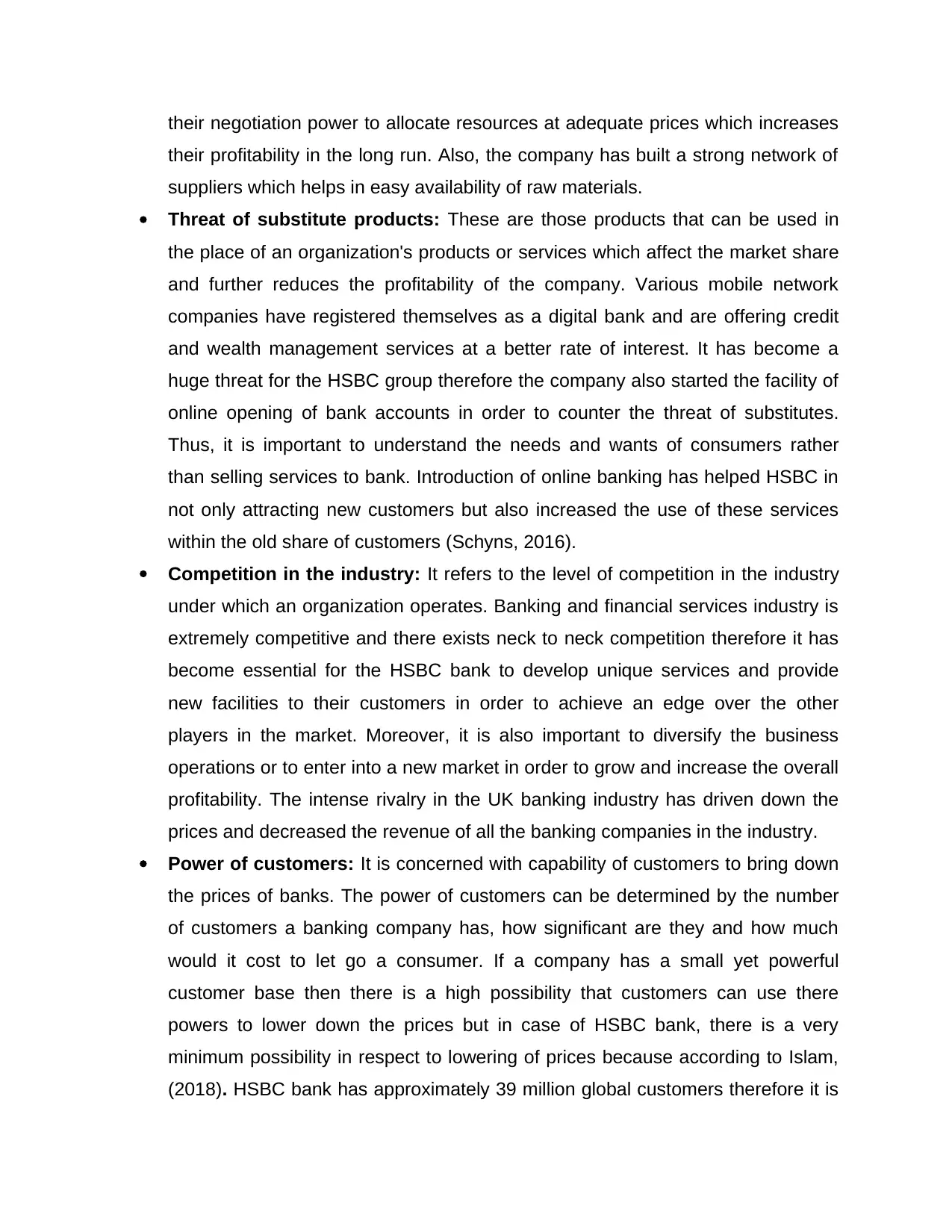
their negotiation power to allocate resources at adequate prices which increases
their profitability in the long run. Also, the company has built a strong network of
suppliers which helps in easy availability of raw materials.
Threat of substitute products: These are those products that can be used in
the place of an organization's products or services which affect the market share
and further reduces the profitability of the company. Various mobile network
companies have registered themselves as a digital bank and are offering credit
and wealth management services at a better rate of interest. It has become a
huge threat for the HSBC group therefore the company also started the facility of
online opening of bank accounts in order to counter the threat of substitutes.
Thus, it is important to understand the needs and wants of consumers rather
than selling services to bank. Introduction of online banking has helped HSBC in
not only attracting new customers but also increased the use of these services
within the old share of customers (Schyns, 2016).
Competition in the industry: It refers to the level of competition in the industry
under which an organization operates. Banking and financial services industry is
extremely competitive and there exists neck to neck competition therefore it has
become essential for the HSBC bank to develop unique services and provide
new facilities to their customers in order to achieve an edge over the other
players in the market. Moreover, it is also important to diversify the business
operations or to enter into a new market in order to grow and increase the overall
profitability. The intense rivalry in the UK banking industry has driven down the
prices and decreased the revenue of all the banking companies in the industry.
Power of customers: It is concerned with capability of customers to bring down
the prices of banks. The power of customers can be determined by the number
of customers a banking company has, how significant are they and how much
would it cost to let go a consumer. If a company has a small yet powerful
customer base then there is a high possibility that customers can use there
powers to lower down the prices but in case of HSBC bank, there is a very
minimum possibility in respect to lowering of prices because according to Islam,
(2018). HSBC bank has approximately 39 million global customers therefore it is
their profitability in the long run. Also, the company has built a strong network of
suppliers which helps in easy availability of raw materials.
Threat of substitute products: These are those products that can be used in
the place of an organization's products or services which affect the market share
and further reduces the profitability of the company. Various mobile network
companies have registered themselves as a digital bank and are offering credit
and wealth management services at a better rate of interest. It has become a
huge threat for the HSBC group therefore the company also started the facility of
online opening of bank accounts in order to counter the threat of substitutes.
Thus, it is important to understand the needs and wants of consumers rather
than selling services to bank. Introduction of online banking has helped HSBC in
not only attracting new customers but also increased the use of these services
within the old share of customers (Schyns, 2016).
Competition in the industry: It refers to the level of competition in the industry
under which an organization operates. Banking and financial services industry is
extremely competitive and there exists neck to neck competition therefore it has
become essential for the HSBC bank to develop unique services and provide
new facilities to their customers in order to achieve an edge over the other
players in the market. Moreover, it is also important to diversify the business
operations or to enter into a new market in order to grow and increase the overall
profitability. The intense rivalry in the UK banking industry has driven down the
prices and decreased the revenue of all the banking companies in the industry.
Power of customers: It is concerned with capability of customers to bring down
the prices of banks. The power of customers can be determined by the number
of customers a banking company has, how significant are they and how much
would it cost to let go a consumer. If a company has a small yet powerful
customer base then there is a high possibility that customers can use there
powers to lower down the prices but in case of HSBC bank, there is a very
minimum possibility in respect to lowering of prices because according to Islam,
(2018). HSBC bank has approximately 39 million global customers therefore it is
⊘ This is a preview!⊘
Do you want full access?
Subscribe today to unlock all pages.

Trusted by 1+ million students worldwide
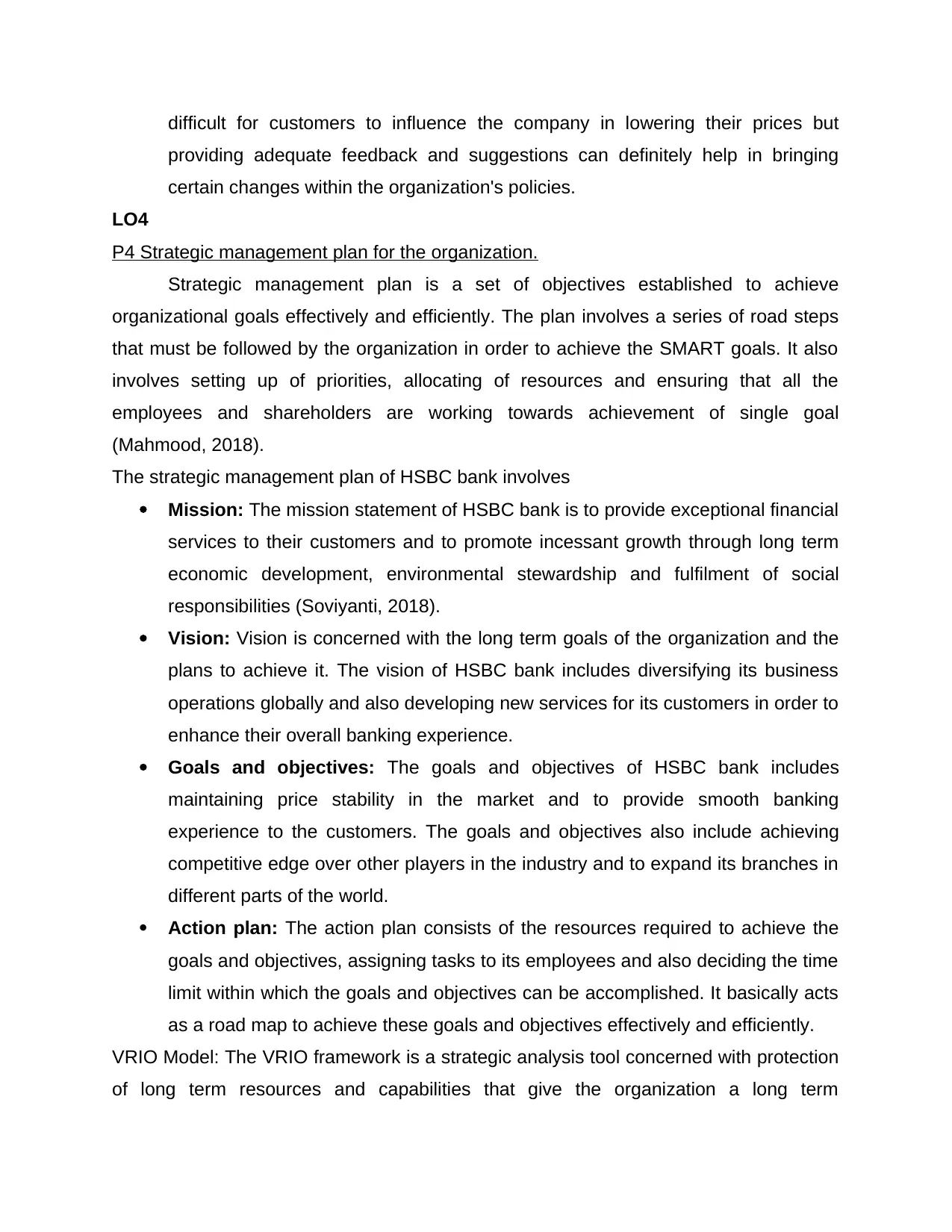
difficult for customers to influence the company in lowering their prices but
providing adequate feedback and suggestions can definitely help in bringing
certain changes within the organization's policies.
LO4
P4 Strategic management plan for the organization.
Strategic management plan is a set of objectives established to achieve
organizational goals effectively and efficiently. The plan involves a series of road steps
that must be followed by the organization in order to achieve the SMART goals. It also
involves setting up of priorities, allocating of resources and ensuring that all the
employees and shareholders are working towards achievement of single goal
(Mahmood, 2018).
The strategic management plan of HSBC bank involves
Mission: The mission statement of HSBC bank is to provide exceptional financial
services to their customers and to promote incessant growth through long term
economic development, environmental stewardship and fulfilment of social
responsibilities (Soviyanti, 2018).
Vision: Vision is concerned with the long term goals of the organization and the
plans to achieve it. The vision of HSBC bank includes diversifying its business
operations globally and also developing new services for its customers in order to
enhance their overall banking experience.
Goals and objectives: The goals and objectives of HSBC bank includes
maintaining price stability in the market and to provide smooth banking
experience to the customers. The goals and objectives also include achieving
competitive edge over other players in the industry and to expand its branches in
different parts of the world.
Action plan: The action plan consists of the resources required to achieve the
goals and objectives, assigning tasks to its employees and also deciding the time
limit within which the goals and objectives can be accomplished. It basically acts
as a road map to achieve these goals and objectives effectively and efficiently.
VRIO Model: The VRIO framework is a strategic analysis tool concerned with protection
of long term resources and capabilities that give the organization a long term
providing adequate feedback and suggestions can definitely help in bringing
certain changes within the organization's policies.
LO4
P4 Strategic management plan for the organization.
Strategic management plan is a set of objectives established to achieve
organizational goals effectively and efficiently. The plan involves a series of road steps
that must be followed by the organization in order to achieve the SMART goals. It also
involves setting up of priorities, allocating of resources and ensuring that all the
employees and shareholders are working towards achievement of single goal
(Mahmood, 2018).
The strategic management plan of HSBC bank involves
Mission: The mission statement of HSBC bank is to provide exceptional financial
services to their customers and to promote incessant growth through long term
economic development, environmental stewardship and fulfilment of social
responsibilities (Soviyanti, 2018).
Vision: Vision is concerned with the long term goals of the organization and the
plans to achieve it. The vision of HSBC bank includes diversifying its business
operations globally and also developing new services for its customers in order to
enhance their overall banking experience.
Goals and objectives: The goals and objectives of HSBC bank includes
maintaining price stability in the market and to provide smooth banking
experience to the customers. The goals and objectives also include achieving
competitive edge over other players in the industry and to expand its branches in
different parts of the world.
Action plan: The action plan consists of the resources required to achieve the
goals and objectives, assigning tasks to its employees and also deciding the time
limit within which the goals and objectives can be accomplished. It basically acts
as a road map to achieve these goals and objectives effectively and efficiently.
VRIO Model: The VRIO framework is a strategic analysis tool concerned with protection
of long term resources and capabilities that give the organization a long term
Paraphrase This Document
Need a fresh take? Get an instant paraphrase of this document with our AI Paraphraser
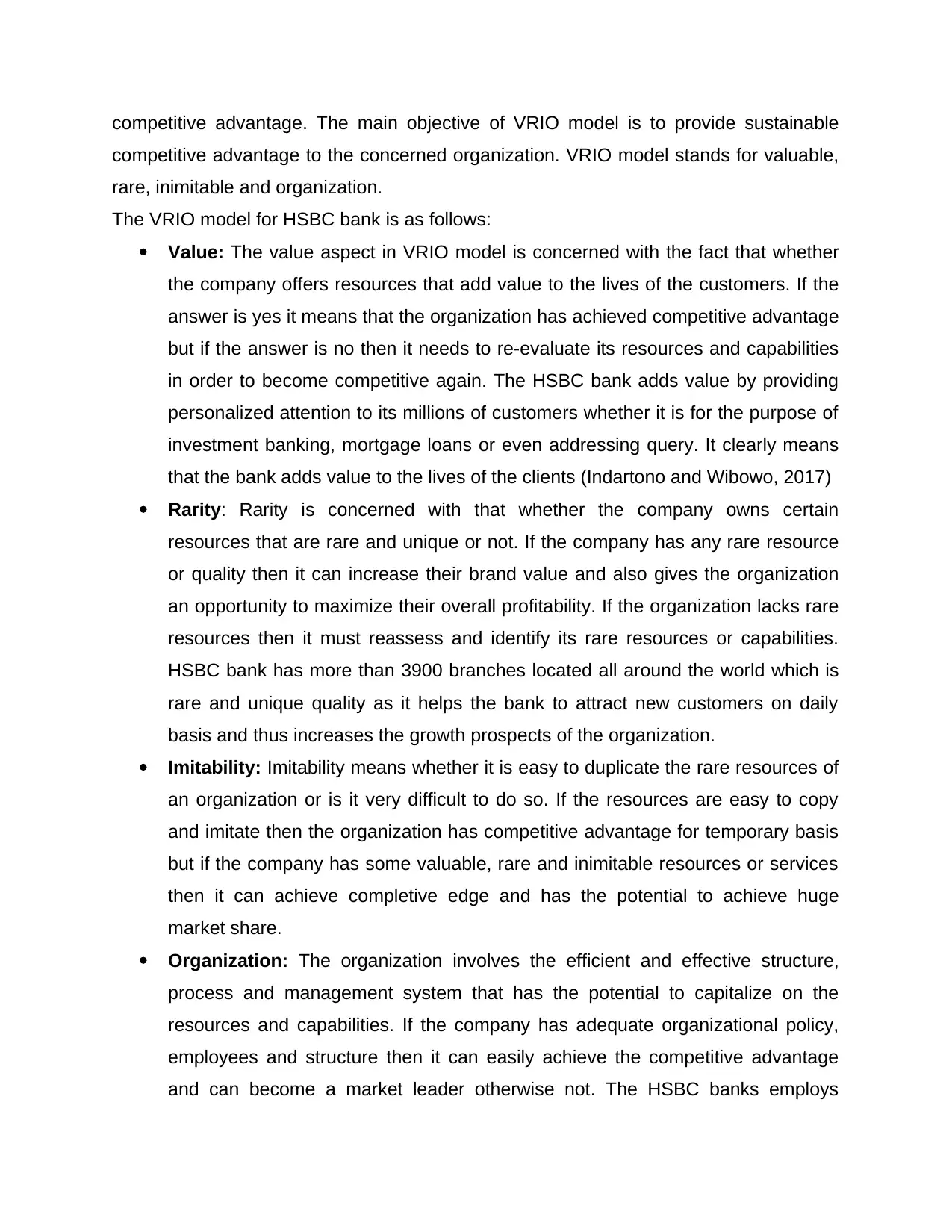
competitive advantage. The main objective of VRIO model is to provide sustainable
competitive advantage to the concerned organization. VRIO model stands for valuable,
rare, inimitable and organization.
The VRIO model for HSBC bank is as follows:
Value: The value aspect in VRIO model is concerned with the fact that whether
the company offers resources that add value to the lives of the customers. If the
answer is yes it means that the organization has achieved competitive advantage
but if the answer is no then it needs to re-evaluate its resources and capabilities
in order to become competitive again. The HSBC bank adds value by providing
personalized attention to its millions of customers whether it is for the purpose of
investment banking, mortgage loans or even addressing query. It clearly means
that the bank adds value to the lives of the clients (Indartono and Wibowo, 2017)
Rarity: Rarity is concerned with that whether the company owns certain
resources that are rare and unique or not. If the company has any rare resource
or quality then it can increase their brand value and also gives the organization
an opportunity to maximize their overall profitability. If the organization lacks rare
resources then it must reassess and identify its rare resources or capabilities.
HSBC bank has more than 3900 branches located all around the world which is
rare and unique quality as it helps the bank to attract new customers on daily
basis and thus increases the growth prospects of the organization.
Imitability: Imitability means whether it is easy to duplicate the rare resources of
an organization or is it very difficult to do so. If the resources are easy to copy
and imitate then the organization has competitive advantage for temporary basis
but if the company has some valuable, rare and inimitable resources or services
then it can achieve completive edge and has the potential to achieve huge
market share.
Organization: The organization involves the efficient and effective structure,
process and management system that has the potential to capitalize on the
resources and capabilities. If the company has adequate organizational policy,
employees and structure then it can easily achieve the competitive advantage
and can become a market leader otherwise not. The HSBC banks employs
competitive advantage to the concerned organization. VRIO model stands for valuable,
rare, inimitable and organization.
The VRIO model for HSBC bank is as follows:
Value: The value aspect in VRIO model is concerned with the fact that whether
the company offers resources that add value to the lives of the customers. If the
answer is yes it means that the organization has achieved competitive advantage
but if the answer is no then it needs to re-evaluate its resources and capabilities
in order to become competitive again. The HSBC bank adds value by providing
personalized attention to its millions of customers whether it is for the purpose of
investment banking, mortgage loans or even addressing query. It clearly means
that the bank adds value to the lives of the clients (Indartono and Wibowo, 2017)
Rarity: Rarity is concerned with that whether the company owns certain
resources that are rare and unique or not. If the company has any rare resource
or quality then it can increase their brand value and also gives the organization
an opportunity to maximize their overall profitability. If the organization lacks rare
resources then it must reassess and identify its rare resources or capabilities.
HSBC bank has more than 3900 branches located all around the world which is
rare and unique quality as it helps the bank to attract new customers on daily
basis and thus increases the growth prospects of the organization.
Imitability: Imitability means whether it is easy to duplicate the rare resources of
an organization or is it very difficult to do so. If the resources are easy to copy
and imitate then the organization has competitive advantage for temporary basis
but if the company has some valuable, rare and inimitable resources or services
then it can achieve completive edge and has the potential to achieve huge
market share.
Organization: The organization involves the efficient and effective structure,
process and management system that has the potential to capitalize on the
resources and capabilities. If the company has adequate organizational policy,
employees and structure then it can easily achieve the competitive advantage
and can become a market leader otherwise not. The HSBC banks employs
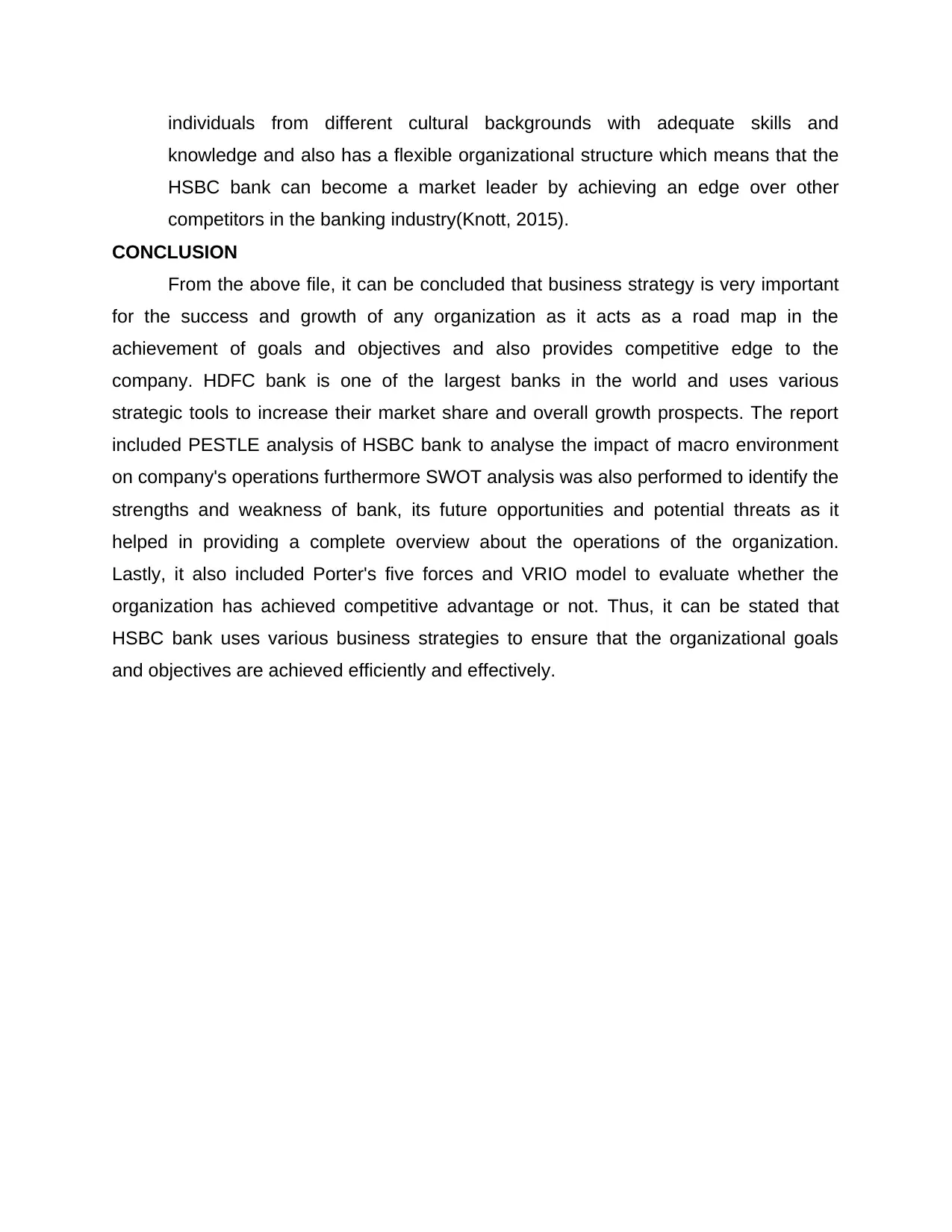
individuals from different cultural backgrounds with adequate skills and
knowledge and also has a flexible organizational structure which means that the
HSBC bank can become a market leader by achieving an edge over other
competitors in the banking industry(Knott, 2015).
CONCLUSION
From the above file, it can be concluded that business strategy is very important
for the success and growth of any organization as it acts as a road map in the
achievement of goals and objectives and also provides competitive edge to the
company. HDFC bank is one of the largest banks in the world and uses various
strategic tools to increase their market share and overall growth prospects. The report
included PESTLE analysis of HSBC bank to analyse the impact of macro environment
on company's operations furthermore SWOT analysis was also performed to identify the
strengths and weakness of bank, its future opportunities and potential threats as it
helped in providing a complete overview about the operations of the organization.
Lastly, it also included Porter's five forces and VRIO model to evaluate whether the
organization has achieved competitive advantage or not. Thus, it can be stated that
HSBC bank uses various business strategies to ensure that the organizational goals
and objectives are achieved efficiently and effectively.
knowledge and also has a flexible organizational structure which means that the
HSBC bank can become a market leader by achieving an edge over other
competitors in the banking industry(Knott, 2015).
CONCLUSION
From the above file, it can be concluded that business strategy is very important
for the success and growth of any organization as it acts as a road map in the
achievement of goals and objectives and also provides competitive edge to the
company. HDFC bank is one of the largest banks in the world and uses various
strategic tools to increase their market share and overall growth prospects. The report
included PESTLE analysis of HSBC bank to analyse the impact of macro environment
on company's operations furthermore SWOT analysis was also performed to identify the
strengths and weakness of bank, its future opportunities and potential threats as it
helped in providing a complete overview about the operations of the organization.
Lastly, it also included Porter's five forces and VRIO model to evaluate whether the
organization has achieved competitive advantage or not. Thus, it can be stated that
HSBC bank uses various business strategies to ensure that the organizational goals
and objectives are achieved efficiently and effectively.
⊘ This is a preview!⊘
Do you want full access?
Subscribe today to unlock all pages.

Trusted by 1+ million students worldwide
1 out of 14
Related Documents
Your All-in-One AI-Powered Toolkit for Academic Success.
+13062052269
info@desklib.com
Available 24*7 on WhatsApp / Email
![[object Object]](/_next/static/media/star-bottom.7253800d.svg)
Unlock your academic potential
Copyright © 2020–2025 A2Z Services. All Rights Reserved. Developed and managed by ZUCOL.




